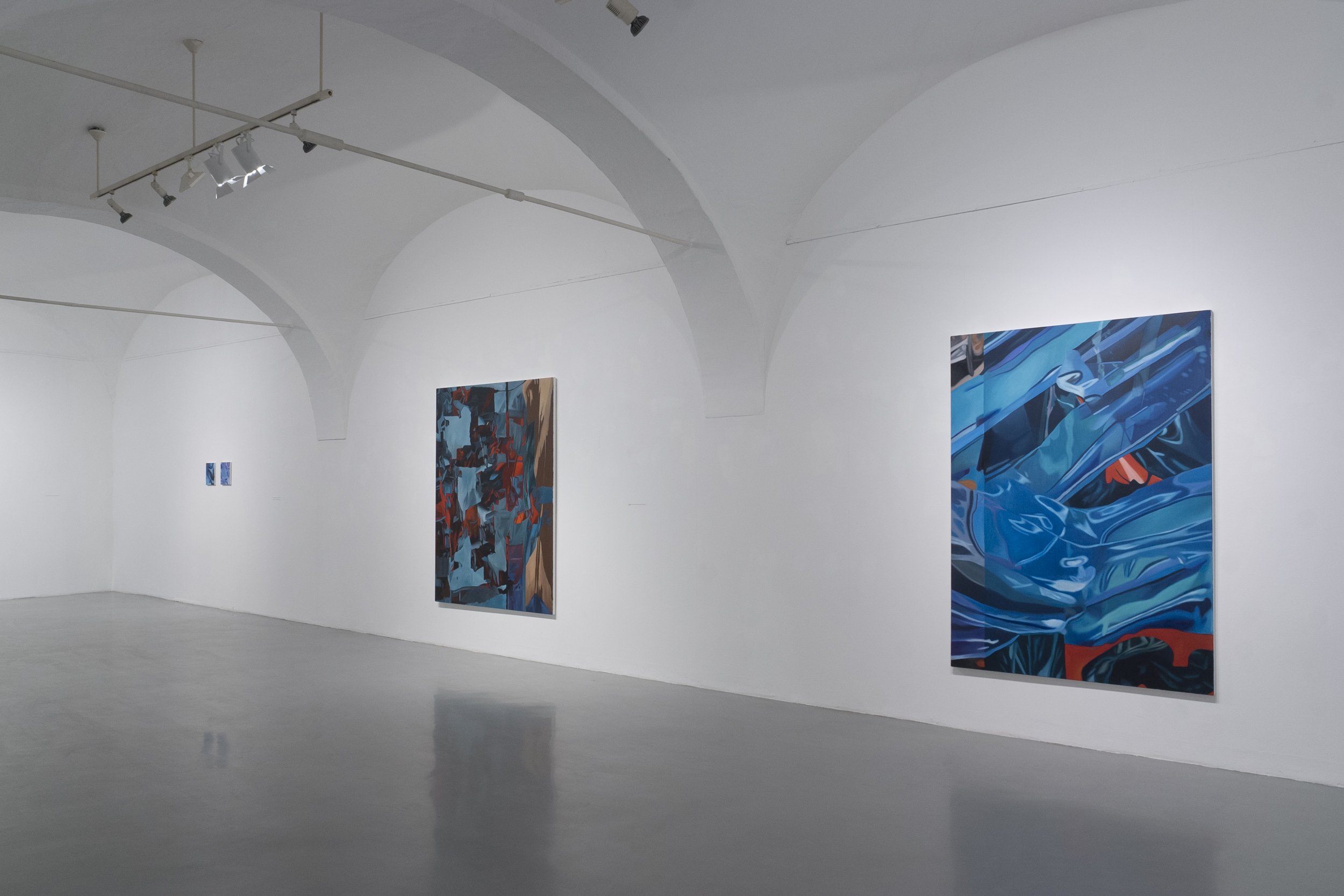Gesture of moral support
Equrna gallery, Ljubljana, 2024
solo show // 30.01..-29.02.2024
Abstractions of the Digital Ether
Marking a pivotal moment in Neža Perovšek's artistic trajectory, her solo exhibition entitled Gesture of Moral Support[1] reveals profound contemplation on abstract painting[2] in the post-internet world. The exhibition features a selection of works mainly created between 2022 and 2023 that demonstrate the artist’s conceptual as well as formal finesse and draw inspiration from both her personal photographic archive and a compulsively accumulated array of various visual materials that she has saved on her computer. Perovšek’s work breaks down conventional boundaries and navigates the complex intersection of contemporary painting, intermedial practices[3], and the transformative ethos of the post-internet age. The paintings on display illustrate the evolving language of abstract images in a time marked by digital interfaces, online platforms, media streaming, and the continuous flow of information, inviting the audience to reflect on the collision of the digital and the analogue, the real and the virtual, the old and the new, etc.
'Imagine somebody from the past with a beret asking you, “Comrade, what is your visual bond today?”[4]
To understand such creative practices, one must also consider that which is not evident from the works themselves and ask what the artist’s approach to their work is or, in other words, what their visual connection is. As for Perovšek, she by no means questions the concept of a painting as an object, because this is not painting rooted in the legacy of high modernism. Instead, her works are more akin to the metaphor of the window, a concept that in the past had a significant impact on how we understood space and representation. In the contemporary digital age, however, the idea of the window has been transformed into screens that act as portals through which individuals come into contact with different interpretations of reality. Perovšek’s paintings, which provide insight into (online) landscapes of digitised images, have the effect of touchscreens that penetrate our lives and blur the boundaries between the physical and the virtual. In this context, her works act as intermediaries that encourage reflection on the nuanced interplay between language, perception, and the mediated experiences that define our existence today. The above thoughts are reinforced by the homogeneous and smooth surface of her paintings, which is reminiscent of a computer or smartphone screen. The colour palette as well inhabits small fragmented surfaces in various complementary hues, creating a dynamic interplay of shapes and other visual elements that mimic the light effects of modern materials or the so-called glitch[5] aesthetic we have become familiar with through the ubiquity of electronic devices. It should also be emphasised that the artist’s creative process does not begin in front of a blank canvas; rather, she documents her ideas in the form of digital images, which she collects and accumulates before the creative act of an individual artwork even takes place. The diverse visual materials, which come from her personal archive of photographs and found sources, are re-assembled into digital collages that reflect today’s media-dominated reality. On closer examination, Perovšek’s abstract images seem to reveal the driving force behind her work – an obsession with collecting and the desire to bring to a halt the continuous flow of visual stimuli. Her gesture acts as a synthesis of both her own and found images that is based on the techniques of appropriation and recontextualisation, creating a visual language that echoes the existence of modern humans.
Neža Perovšek’s paintings result from the transformation that images undergo in the process of conversion from digital to physical form, and emphasise the internal tension between the original and the reproduced. The once impoverished[6] online images speak not only of their immediate visual impact, but also of their journey through digital dispersion, fragmentation, and their adaptation and transformation, which in this exhibition is further amplified by being translated into the field of fine art. The exhibition Gesture of Moral Support acts as a visual manifesto on the state of abstraction in our post-internet world and encourages reflection on the evolving nature of painting that offers a unique symbiosis between the tangible and the digital, and the abstract and the concrete.
Adrijan Praznik
[1] This expression is taken from Nonverbal Communication: Notes on the Visual Perception of Human Relations by Jurgen Ruesch and Weldon Kees (University of California Press, 1970, p. 85).
[2] Painting that does not depict but deals with the formal laws of the medium.
[3] In reference to the production process of artworks, which it would be more appropriate to place closer to intermediality.
[4] Hito Steyerl, In Defense of the Poor Image, e-flux Journal, Issue 10, November 2009, https://www.e-flux.com/journal/10/61362/in-defense-of-the-poor-image/.
[5] A sudden, usually temporary, hardware or software malfunction or failure.
[6] The poor or impoverished images that Hito Steyerl writes about are characterised by low resolution and artifacts caused by the compression of data. As the internet keeps becoming faster and processing power increasing, it is ever more difficult to talk about “impoverishment” at the expense of the quality of individual images. Moreover, many artists who take inspiration from poor or other found images are doing the opposite – they are modifying digitised images and translating them into a material rendition. In this respect, Perovšek’s works are about something that has been lost, but also about something that has been acquired, about new qualities and characteristics that the images did not have beforehand. After all, the very historical and symbolic value of the painting medium inherently changes the context of how the presented motifs are seen.
text author: Adrijan Praznik
english translation: Miha Šuštar
english proofreading: Dean DeVos













